Photographs: Vijay Mathur/Reuters Rediff Business Desk
Pranab Mukherjee's fourth budget
This is Finance Minister Pranab Mukherjee's fourth regular Budget. He presented three Budgets as finance minister in the Indira Gandhi government. But this would perhaps be his toughest job as he has to fight recessionary pressures and at the same time meet the fiscal deficit reduction targets.
Mukherjee points out that the focus of the government would be aam aadmi (the common man) with more employment generation schemes on the anvil.
With the Union Budget to be presented on July 3, the finance minister has started having discussions with senior ministry officials, industrialists and economists to chalk out a strategy to revive the economy.
India's Gross Domestic Product (GDP) rose by 7.5 per cent, 9.5 per cent, 9.7 per cent and 9 per cent in the first four years from fiscal year 2004-05 to 2007-08 recording a sustained growth of over 9 per cent for three consecutive years for the first time.
But the 'India shining' story took a beating with the economic crisis. India's growth rate is now at 6.7 per cent in the wake of a global slowdown. Mukherjee has said the government will push for economic reforms to boost investment and development of core sector.
He said the government would increase its spending to restore growth and employment through additional borrowing.
Economists have urged the finance minister to increase public investment in infrastructure to boost the economy reeling under the impact of the global financial meltdown. The economists also sought a simplification of tax structure. So here's what you could expect in the Budget. . .
What to expect from the Budget
Image: A worker at a gas station counts currency notesPhotographs: Amit Gupta/Reuters
The Budget is likely to see a fourth economic stimulus package from the government aimed at providing much-needed succour to the ailing industry.
Divestment seems to be the answer for the funds. The stake sale in public sector units will add crores (billions) of rupees to the government's kitty.
The auction of 3G spectrum will also help the government mobilise more funds.
Infrastructure projects will get a fillip in the Budget. Many big ticket proposals in the sectors will be given the green signal.
Exports have dropped by 33.2 per cent to $10.74 billion in April, the highest fall in the last 14 years. Commerce Minister Anand Sharma said that there would be a stimulus package for exports in this Budget.
Banks may be aggressively urged to lower lending rates as interest rates in India are among the highest in the world.
Industry may get some respite on taxes. Finance ministry officials have, however, told industry officials that there is no room for big sops and incentives. The government had cut excise duty across-the-board by 4 percentage points and service tax by 2 percentage points in the two earlier stimulus packages.
What to expect from the Budget
Image: A labourer carries a roll of cloth at a roadside dye factory in Siliguri.Photographs: Rupak De Chowdhuri/Reuters
Big expectations
The rules relating to foreign investment in the insurance and pension sectors may be eased.
The draconian Fringe Benefit Tax could be abolished.
The textiles, leather and gems and jewellery sectors hit hard by the financial crisis are likely to get more relief from the government. Credit flow is likely to be eased to revive these sectors.
The government is set to allocate more grants for the social sector. The allocations for the National Rural Employment Guarantee Scheme (NREGS) and the Backward Regions Grants Fund (BRGF) are likely to be hiked.
Many industrialists believe that Mukherjee might introduce measures to hike subsidies, put in place series of low-cost housing schemes and revamp public distribution system.
The government might rationalise the duty structure for the textiles sector. The over Rs 2 trillion domestic textiles industry is struggling to meet targets and has been one of the hardest hit in the global slowdown.
So what are the major issues?Banks may be forced to lower lending rates as interest rates in India are among the highest in the world.
Industry may get some respite on taxes. Finance ministry officials have however told industry officials that there is no room for big sops and incentives. The government had cut across-the-board by four percentage points excise duty and two percentage points service tax in two stimulus packages.
What to expect from the Budget
Image: Finance Minister Pranab Mukherjee on his first day in the office in New Delhi.Photographs: B Mathur/Reuters
Major issues
Containing fiscal deficit is huge task for the finance minister. The fiscal deficit is estimated to be about Rs 332,000 crore (Rs 3.32 trillion, three times the level in the previous year of Rs 1,33,000 crore (Rs 1.33 trillion).
Mukherjee said that the budget would spell out policies and priorities of the new government and focus on issues and concerns on economy particularly regarding sectors badly hit by the global economic meltdown.
The finance minister will also have to address the issue of rising prices of essential commodities even as the inflation rate is at a record low
Extension of the industry-friendly STPI scheme for at least five years, speedy enactment of the recent clarification pertaining to the SEZ scheme, service tax on software, are among the key issues the Budget might address.
GDP growth: Maintaining and stimulating GDP growth will be at the top of the priority list of the finance minister.
Fiscal deficit: The fiscal deficit has gone up quite sharply due to the stimulus packages announced by the government. The finance minister will have to be cautious. He might come out with some short- and medium-term targets to reduce the fiscal deficit over the next few years.
What to expect from the Budget
Image: The Bombay Stock Exchange is lit up during Diwali.Photographs: Arko Datta/Reuters
Reforms hold the key
Reforms: Reforms are another area where the markets have huge expectations from the new budget. Many sectors want foreign direct investment reforms - real estate, retail, banking and insurance to name a few.
Decontrolling fuel prices is another important aspect which requires attention from the government.
Infrastructure growth: Infrastructure is an area that requires immediate attention to ensure sustained growth over the next many years. Massive investments are required in road projects, energy projects, etc.
Income tax: People are expecting a sentiment booster from the finance minister through an increase in the slabs, and therefore a reduction in the income tax burden. Reducing income tax is a sentiment booster and indirectly reflects in the consumer sentiments.
What to expect from the Budget
Image: Manmohan Singh (L), Sharad Pawar (C) and Pranab MukherjeePhotographs: Reuters
Divestment top on govt's agenda
Prime Minister Manmohan Singh indicated that the full Budget for 2009-10 may announce a divestment of government stake in public sector companies.
Fiscal prudence and divestment of public sector units -- all these issues will be tackled by the finance minister in the Budget.
The prime minister said that economic growth would not come at the cost of fiscal prudence. "We would ensure economic growth momentum but at the same time fiscal prudence will be kept in mind," he said.
The finance ministry is looking at a proposal that seeks to dilute the government's stake in all listed public sector undertakings to at least 90 per cent.
The government is required to pass the budget and get it approved by the Parliament by July 31. This will allow the government to withdraw money from the Consolidated Fund of India as it expires on that date.
And what does the industry want?
What to expect from the Budget
Image: Indian currency notes at a bank.Representatives of the Indian industry met the finance minister and urged the government to boost investment and generate demand.
The Confederation of Indian Industry (CII), Federation of Indian Chambers of Commerce and Industry (FICCI) and Associated Chambers of Commerce and Industry of India (Assocham) said Pranab Mukherjee should aim to ensure 8-9 per cent growth rate during the current financial year and take it to 11 per cent in 2010-11.
They said the government must remove fringe benefit tax, bring down corporate taxes and offer the public relief from the huge tax burden in these difficult times.
CII, however, did not call for another stimulus package in the full Budget for 2009-10.
Calling for another stimulus package for speeding up growth, industry body Assocham said the new UPA government should go in for disinvestment of leading public sector companies and banks up to 49 per cent.
"PSU disinvestment would also stimulate the stock market," Assocham President Sajjan Jindal said adding that the chamber would submit an action plan for the government to Prime Minister Manmohan Singh soon.
It said under the 100-day plan, the government should accord 'Navratna' status to major public sector banks.
What to expect from the Budget
Image: A worker shows his empty wallet.Photographs: Jagadeesh NV/Reuters
More stimulus for the economy
A total stimulus package worth Rs 1 lakh crore (Rs 1 trillion) should be announced to stimulate housing, construction and real estate sectors, the Assocham said.
There has also been a demand for increasing depreciation rates for plant and machinery from 15 per cent to 25 per cent, and introducing an investment allowance package for businesses for cost savings.
It said that Foreign Direct Investment (FDI) in insurance sector should be increased from 26 per cent up to 49 per cent.
Seeking further reduction in interest rates, Jindal said export zones require sustained support as these have suffered the most in the recent past and may not recover till late 2009 fiscal. Also, the small scale sector should get credit at a lower rate.
Assocham said, there is a need to reduce both personal tax and corporate tax by five percentage points so that public spending can be increased.
Besides, a new deadline for Goods and Service Tax (GST) should be rolled out to put it into place by the next year as its introduction by 2010 is likely to get delayed, it added.
It also sought a housing policy to provide houses for rural families within five years based on a 20-year repayment at extremely low interest rates.
What to expect from the Budget
Image: A farmer walks through his sunflower crop in a farm at Dayalpura village in Punjab.Photographs: Ajay Verma/Reuters
Agriculture sector needs a boost
On the agricultural sector, the chamber said there is a need for a long-term farm policy aimed at promoting farmer-industry interaction, development of efficient supply chains to connect farmers to urban consumers and processing industry.
Jindal said, low priced rice, wheat, dal and kerosene should be made accessible to all below poverty line families.
FICCI president Harsh Pati Singhania emphasised the need for agriculture and social sector reforms to push growth.
He also called for initiatives for ensuring education for children of below poverty level. He suggested the setting up of a finance company to provide loans and also financial benefits to enroll them in schools.
Assocham senior vice-president Swati Piramal highlighted the need to improve infrastructure, efficiency and maintain growth.
What to expect from the Budget
Image: Employees at a Indian call centre.Photographs: Sherwin Crasto/Reuters
The IT industry representatives met the finance minister and urged him to extend the STPI scheme for at least five years, speedy enactment of the recent clarification pertaining to the SEZ scheme, service tax on software, and withdrawal of FBT.
IT and Communication Minister A Raja has said he would seek a two-year extension of tax concession available under STPI scheme.
They also asked the government to clarify issues related to protectionism in the US market.
Meanwhile the IT hardware industry has called for parity in the countervailing duty (CVD) and service tax, levied on IT hardware products, in a pre-budget memorandum submitted to Finance Minister Pranab Mukherjee.
"It is strongly recommended that the rate of service tax be aligned to that of the excise duty/CVD to avoid structural anomalies," the Manufacturers' Association for Information Technology (MAIT) said.
Currently, the service tax is pegged at 10 percent while the rate of excise duty/CVD is 8 percent.


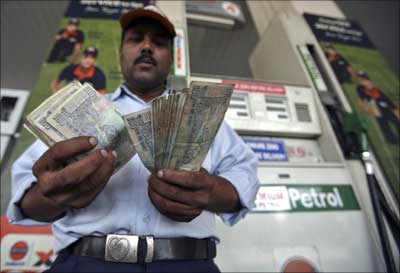

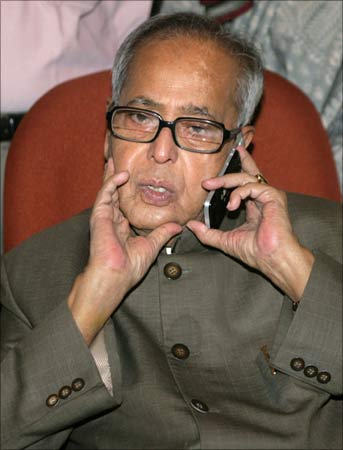


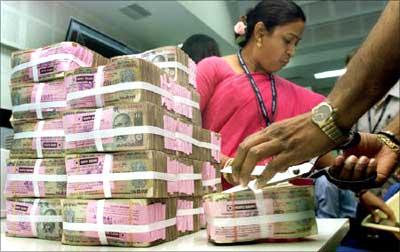
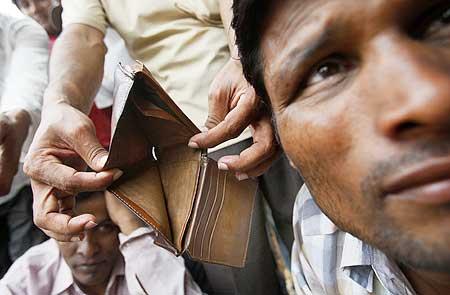

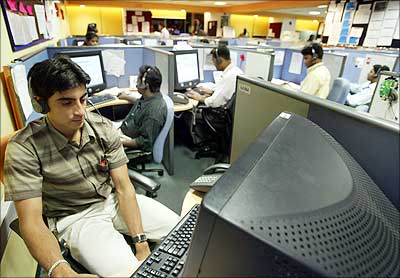
article